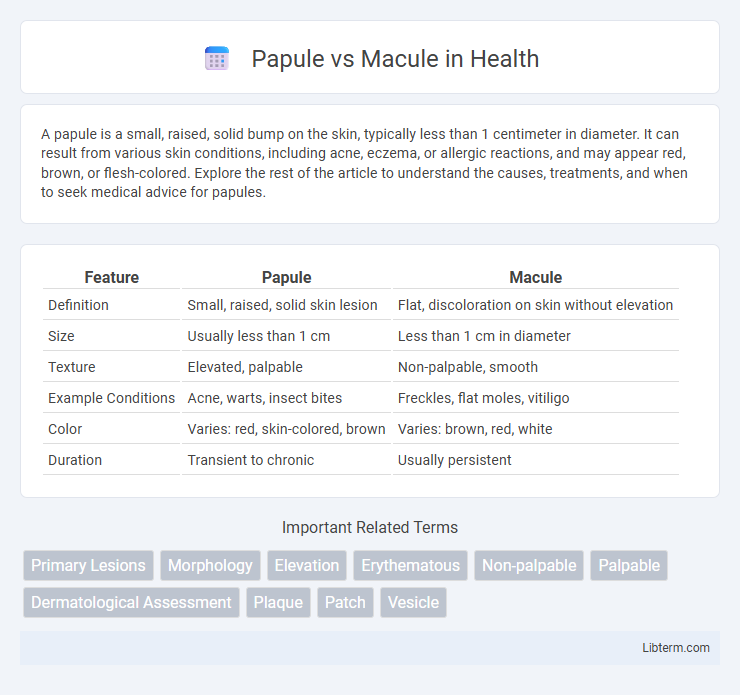A papule is a small, raised, solid bump on the skin, typically less than 1 centimeter in diameter. It can result from various skin conditions, including acne, eczema, or allergic reactions, and may appear red, brown, or flesh-colored. Explore the rest of the article to understand the causes, treatments, and when to seek medical advice for papules.
Table of Comparison
| Feature | Papule | Macule |
|---|---|---|
| Definition | Small, raised, solid skin lesion | Flat, discoloration on skin without elevation |
| Size | Usually less than 1 cm | Less than 1 cm in diameter |
| Texture | Elevated, palpable | Non-palpable, smooth |
| Example Conditions | Acne, warts, insect bites | Freckles, flat moles, vitiligo |
| Color | Varies: red, skin-colored, brown | Varies: brown, red, white |
| Duration | Transient to chronic | Usually persistent |
Understanding Papules and Macules
Papules and macules are both types of skin lesions with distinct characteristics; papules are elevated, solid lesions less than 1 centimeter in diameter, often resulting from inflammation or infection, whereas macules are flat, discolored spots on the skin without elevation or texture change. Understanding the difference between papules and macules is essential for accurate dermatological diagnosis, as papules indicate raised abnormalities such as acne or warts, while macules often represent pigment changes like freckles or rashes. Accurate identification involves assessing the lesion's size, texture, color, and elevation to differentiate papules from macules effectively.
Defining Papules: Key Characteristics
Papules are small, raised, solid skin lesions less than 1 centimeter in diameter, often resulting from inflammation, infection, or allergic reactions. Unlike macules, which are flat and purely color changes on the skin, papules have a palpable texture that can be rough, smooth, or scaly. Common in dermatological conditions such as psoriasis, acne, and dermatitis, papules are crucial for diagnosis due to their distinctive elevation and surface characteristics.
Defining Macules: Key Characteristics
Macules are flat, distinct, discolored areas of skin less than 1 centimeter in diameter without any elevation or depression. These lesions differ from papules, which are raised and palpable due to localized skin thickening. Identifying macules relies on visual inspection of color changes, often seen in conditions like freckles, vitiligo, or petechiae.
Major Differences Between Papules and Macules
Papules are small, raised, solid skin lesions usually less than 1 centimeter in diameter, whereas macules are flat, discolored spots on the skin without any elevation. Papules indicate a palpable change in the skin texture often associated with inflammation or infiltration, while macules reflect a change in skin color due to pigmentation or vascular changes without altering skin texture. These differences are clinically significant for diagnosing dermatological conditions such as acne, psoriasis (papules), or vitiligo and freckles (macules).
Causes of Papules and Macules
Papules are caused by inflammation, infections, or skin conditions such as acne, eczema, and psoriasis, leading to raised, solid lesions typically less than 1 centimeter in diameter. Macules result from pigment changes or vascular abnormalities, including conditions like freckles, vitiligo, or petechiae, presenting as flat, discolored spots on the skin. Both papules and macules can arise from allergic reactions, insect bites, or chronic skin diseases but differ primarily in texture and depth.
Common Locations on the Body
Papules commonly appear on areas with frequent friction or sun exposure, such as the face, scalp, neck, and upper trunk, whereas macules are often found on the skin of the face, hands, and forearms. Papules are raised, solid lesions typically seen in conditions like acne and psoriasis, frequently affecting sebaceous gland-rich regions. Macules are flat, discolored spots found in pigmentary disorders, frequently manifesting on sun-exposed areas due to melanin changes.
Diagnosis: Identifying Papules vs Macules
Papules are elevated, solid skin lesions typically less than 1 centimeter in diameter, while macules present as flat, discolored spots without elevation. Diagnosis involves visual and tactile examination, where papules can be felt as raised bumps, contrasting with macules that are only distinguishable by color changes on the skin surface. Dermoscopy and biopsy may aid in differentiating these lesions, especially when the diagnosis is unclear in inflammatory or neoplastic conditions.
Clinical Importance in Dermatology
Papules and macules are key dermatological lesions that differ in clinical appearance and diagnostic significance; papules are elevated, solid lesions less than 1 cm in diameter, often indicating inflammatory or neoplastic processes, while macules are flat, nonpalpable discolorations signaling pigmentary changes or vascular abnormalities. Accurate identification of papules versus macules is essential for diagnosing conditions like psoriasis, dermatitis, melanoma, and vitiligo, guiding appropriate treatment and prognosis. Understanding their distinct morphological features aids dermatologists in differential diagnosis and helps monitor disease progression or response to therapy.
Treatment Approaches for Papules and Macules
Treatment approaches for papules primarily involve topical corticosteroids or retinoids to reduce inflammation and promote skin cell turnover, while macules often require addressing the underlying cause, such as sun protection for post-inflammatory hyperpigmentation or topical lightening agents like hydroquinone. Papules may also benefit from oral antibiotics or immunomodulators in cases of acne or inflammatory dermatoses, whereas macules typically do not necessitate aggressive treatment unless associated with pigmentation disorders. Accurate diagnosis is essential to tailor therapy, ensuring effective management of both papules and macules based on their etiology and skin type.
When to See a Dermatologist
Persistent or rapidly changing papules and macules, especially those that become itchy, painful, or bleed, warrant a consultation with a dermatologist to rule out conditions like eczema, psoriasis, or skin cancer. If lesions do not improve with over-the-counter treatments within two weeks or present with unusual colors, shapes, or sizes, professional evaluation is essential. Early diagnosis by a dermatologist ensures appropriate management of underlying skin disorders and prevents potential complications.
Papule Infographic

 libterm.com
libterm.com